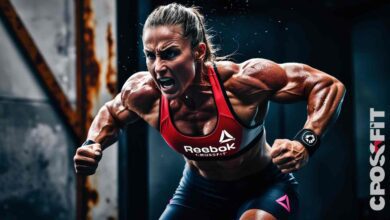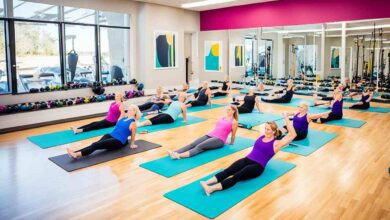
Getting ready for yoga class is more than just bringing your mat. You need the right gear and equipment for a safe and fun practice. This guide will show you the must-have items for your next yoga session.
Whether you’re new to yoga or have been practicing for years, the right gear makes a big difference. We’ll cover everything from the best yoga mat to helpful props. You’ll be ready and confident for your yoga class.
Key Takeaways
- Bring your own yoga mat to ensure cleanliness and availability.
- Wear comfortable, breathable, and form-fitting yoga attire for optimal movement.
- Stay hydrated with a water bottle to replenish fluids during and after your practice.
- Pack a change of clothes and a post-yoga snack for convenience and recovery.
- Approach your yoga class with an open mind to fully benefit from the practice.
Yoga Attire: Essentials for Comfort and Movement
Choosing the right yoga clothes is key to a great practice. Yoga pants, yoga shorts, yoga tops, and yoga sports bras should be comfy and flexible. They should also let you move freely. Look for activewear made from moisture-wicking, breathable fabrics.
Yoga Pants and Shorts
Go for yoga pants and yoga shorts with good stretch and support. Don’t wear loose clothes that could get in the way or show too much. Form-fitting clothing keeps you comfortable and lets you focus on your moves.
Form-Fitting Tops
For your top, pick form-fitting tops that won’t move around. They should keep you covered and comfy, letting you move easily.
Sports Bras for Support
A good yoga sports bra is a must, especially for intense yoga. Find one that supports you well and keeps you comfy, so you can focus on your practice.
Investing in the right yoga attire lets you move freely and stay comfy. The best activewear balances function and style.
Hydration: Bring a Water Bottle
Staying hydrated is key during your yoga practice, especially if it’s a sweaty or hot class. Make sure to bring a reusable yoga water bottle to class. Choose a big bottle, at least 24 ounces, to keep up with your hydration needs.
Also, think about bringing an electrolyte-rich drink like coconut water. These drinks help replace minerals lost when you sweat, preventing muscle cramps and tiredness. It’s good to drink 3 to 8 ounces of water every 15 minutes during class to stay hydrated during yoga.
Being well-hydrated is important not just during your yoga time. Try to drink about 20 ounces of water a couple of hours before your class. Keep drinking water all day to keep your hydration up. Using a reusable water bottle for your yoga sessions helps you stay energized and focused.
“Losing even 2% to 5% of your body weight in fluid can decrease performance by up to 30%.”
Your Own Yoga Mat
Yoga studios often give out mats, but having your own can make your practice better. It makes it more personal and clean. When picking a yoga mat, think about its thickness and the materials it’s made of.
Choosing the Right Mat
The thickness of your yoga mat changes how you practice. Thicker mats, from 5mm to 8mm, give lots of cushioning and support. They’re great for those who need extra support, especially in poses that put pressure on the joints.
Thinner mats, around 3mm to 4mm, offer better stability. They let you feel closer to the ground. This is good for those who want a stronger connection to the floor.
The materials of yoga mats are also important. PVC yoga mats are known for their grip and long life. Rubber yoga mats are eco-friendly and give good grip. If you care about the planet, look into sustainable yoga mats made from natural stuff like jute or cork.
| Mat Thickness | Ideal For |
|---|---|
| 3mm – 4mm | Better stability and grounded feel |
| 5mm – 8mm | Extra cushioning and support |
Choosing the right yoga mat depends on what you like and what you need from your practice. Try out different thicknesses and materials to see what works best for you.
Yoga Towel for Sweat Management
A yoga towel is key for your yoga practice, especially for hot yoga or sweaty sessions. It absorbs moisture to prevent slipping on your yoga mat. Choose a microfiber yoga towel for its grip and stability.
Wet the yoga towel a bit before class for better grip on your yoga mat. This trick helps you stay stable and focused during your practice.
For any sweaty yoga session, a sweat-absorbing towel is crucial for comfort and safety. Get a top-notch hot yoga towel to improve your practice and keep you steady on your yoga mat towel.
“A good yoga towel is a game-changer for any sweaty practice. It helps me stay focused and confident, without worrying about slipping and sliding.”
When picking a yoga towel, think about size, material, and grip. A microfiber yoga towel is great because it absorbs sweat well and dries fast. Also, choose one with a textured surface or non-slip backing for better grip.
Using a yoga towel makes cleaning up after class easier, keeping your yoga mat clean and dry. A quality, sweat-absorbing towel can make your yoga experience better and keep you safe and comfortable.
Accessories for Convenience
Yoga is more than just the practice itself. It’s also about the accessories that make your experience better. Things like change of clothes and snacks for after yoga can make your journey more comfy and easy.
Change of Clothes
Having a change of clothes for yoga is super useful. After a tough practice, you might want to change out of your sweaty clothes. This lets you easily move on to other things or errands without feeling sticky and uncomfortable.
Post-Yoga Snacks
It’s important to refuel after yoga. So, pack a healthy snack like a protein bar or some nuts. These snacks give you the energy you need to keep going and feel good, ready for the rest of your day.
Adding these simple accessories to your yoga routine makes your experience better. It makes sure you enjoy your practice and feel good after it. Yoga is all about balance and harmony, and the right accessories help with that.
Open Mind: The Most Essential Gear
Starting your yoga journey means bringing an open and ready yoga mindset. Come to your yoga practice with curiosity and a kind heart. Don’t worry about how you compare to others. Focus on connecting your mind and body, and enjoy the journey.
Having an open yoga mindset as a yoga beginner makes your yoga experience better. Let go of expectations and judgments to grow and change. Be patient with yourself and ask for help when needed. Your yoga practice is for you, not a race.
“The most important piece of yoga gear you can bring is an open mind.” – Anonymous Yoga Instructor
Yoga benefits are more than just physical. A mindful, non-judgmental yoga mindset lets you connect deeply with your body, mind, and spirit. So, leave your doubts behind and explore your yoga journey with wonder and kindness.
Yoga Blocks for Support
Yoga blocks are essential for yogis at every level. They help with support and alignment during your practice. If you’re new or not very flexible, they’re a big help. They let you adjust poses like standing, forward bends, and backbends.
Choose blocks that are at least 4 inches wide for stability. Cork and foam are top choices. Cork is good because it’s natural and doesn’t grow bacteria. Foam is light and easy to hold.
| Product | Price | Customer Reviews | Key Features |
|---|---|---|---|
| Ananday Yoga Block & Strap Set | $50.00 (down from $62.00) | 8 reviews |
|
| Manduka Cork Block | $24.00 | 88 rating |
|
| Manduka UnBlok Foam Block | $26.00 | 81 rating |
|
| JBM International Strap and 2-Block Set | $30.00 | 79 rating |
|
| Gaiam Yoga Essentials Block | $10.00 | 70 rating |
|
Yoga blocks aren’t just for beginners. Even experienced yogis use them to deepen their practice and get better alignment. Try using yoga blocks and yoga props in your yoga for flexibility and yoga modifications. They can help you reach new levels in your practice.
Straps and Belts for Flexibility
Yoga straps and belts are great tools to help you stretch further and move better. They let you reach deeper into poses like forward bends and shoulder stretches. They also help keep your body in the right position in poses where you can’t quite touch your hands behind your back.
When picking a strap or belt, think about the material. Cotton is strong and feels good, making it a good choice. The type of ring on the belt matters too – a D-ring is usually the easiest to use.
Yoga straps and belts are super useful in these poses:
- Forward Bend: Use a strap to hold onto your feet and deepen the stretch in your hamstrings.
- Cow Head Pose: A strap can assist in bringing your hands together behind your back.
- Boat Pose: Grip a strap between your feet to help maintain the pose and engage your core.
- Dancer Pose: Use a strap to hold your lifted leg and improve your balance and flexibility.
These tools aren’t just for beginners. Even experienced yogis use them to get into deeper poses and improve their practice. Adding straps and belts to your routine can help you move forward faster and avoid injuries by offering support and stability.
| Product | Price |
|---|---|
| Yogamatters Hemp Yoga Belt | £12.00 |
| Yogamatters Organic Cotton Chambray D-ring Yoga Belt | £8.00 |
| Yogamatters Organic Cotton Wide Yoga Belt | £10.00 |
| Yogamatters Organic Cotton Classic Yoga Belt | £6.00 – £9.50 |
| Yoga Design Lab Yoga Strap – Tribeca Sand | £16.00 |
| Manduka AligN Yoga Strap | £20.00 – £22.00 |
“Yoga straps and belts are essential props that can help yogis of all levels deepen their practice and prevent injuries.”
Yoga
Yoga is an ancient practice that helps with physical, mental, and spiritual health. It’s great for both beginners and experts. It’s a journey of self-discovery and growth.
With regular practice and the right gear, you can get stronger, more flexible, and balanced. Yoga started in ancient India and has grown over time. It includes many styles and is part of Hinduism, Buddhism, and Jainism.
The Yoga Sutras of Patanjali are key to yoga’s philosophy. They date back to the early centuries. Hatha yoga texts from the ninth to 11th centuries also shaped yoga’s physical and spiritual parts.
In the West, “yoga” often means modern Hatha yoga. This type focuses on poses, stress relief, and relaxation. It’s popular, with over 20 million Americans practicing. But, it’s important to do it safely.
A 2013 review found 76 cases of yoga-related injuries. Most were in the muscles, nerves, or eyes. Some poses and breathing exercises can be risky. But, most people got better with time. This shows the need for a good teacher, especially for beginners.
“Yoga is the journey of the self, through the self, to the self.” – The Bhagavad Gita
Yoga helps with your body, mind, and spirit, no matter your skill level. Welcome it with an open heart and mind. Let yoga’s wisdom help you find better health, balance, and self-awareness.
| Yoga Benefits | Yoga Styles |
|---|---|
|
|
To get the most from yoga, listen to your body and respect your needs. Be patient, dedicated, and open-minded. Yoga can lead you to better health, balance, and self-discovery.
Conclusion
When it comes to yoga essentials, having the right gear is key. This includes comfy, breathable clothes, a quality yoga gear guide, a water bottle, a yoga towel, and tools like blocks and straps. With the right yoga class preparation gear and an open mind, you’re set to enjoy your yoga practice tips fully.
Remember, the most crucial thing is to be kind to yourself and eager to learn. With the right yoga equipment recommendations and a positive outlook, you’re ready for a transformative yoga journey.
Yoga and meditation have been around for ages, offering many benefits for your body, mind, and emotions. Wrapping up a yoga project lets you reflect and close the chapter, bringing together all you’ve learned and experienced. Writing a thoughtful conclusion leaves a strong impact, summarizing main points and sharing personal stories that deepen the topic.
Yoga boosts flexibility, strength, posture, and helps reduce stress and anxiety. It’s vital to make yoga a part of your daily life. Encouraging you to try yoga motivates you to take steps towards a balanced life of body, mind, and soul. Regular yoga practice builds flexibility, strength, and mindfulness, leading to a more balanced and peaceful life.
FAQ
What should I bring to a yoga class?
For your yoga class, you’ll need comfy, breathable clothes. Don’t forget a good yoga mat, a water bottle, a yoga towel, and blocks and straps if needed.
What type of clothing is best for yoga?
Choose yoga pants and shorts that stretch and breathe well. They should let you move freely. Pick tops that fit close to your body for stability in poses. A good sports bra is key, especially for intense yoga.
Why is staying hydrated important during yoga?
Hydration is crucial during yoga, especially for hot or sweaty classes. Bring a reusable water bottle to class to drink water as you practice.
Do I need to bring my own yoga mat?
Most studios have mats, but bringing your own is a good idea. It ensures a clean, personal practice. When picking a mat, think about the thickness and material that suits you best.
What is a yoga towel used for?
A yoga towel is a must-have for hot or sweaty yoga. It absorbs moisture, preventing slipping on your mat.
What other accessories should I bring to a yoga class?
Consider bringing yoga blocks for proper alignment and straps or belts to improve flexibility. These accessories can make a big difference in your practice.
What is the most important thing to bring to a yoga class?
The most crucial thing for yoga is a positive mindset. Come to class with curiosity, kindness towards yourself, and a readiness to learn.
Source Links
- 7 Essentials to Bring to Your First Yoga Class
- Essential and Optional Yoga Equipment for Beginners
- How to Choose the Most Comfortable Yoga Clothes for Your Practice
- Men’s Guide to Yoga Attire: What to Wear – HiTONE Fitness
- Comfort Meets Function: The Best Clothes for Yoga and Why They’re Essential
- Yoga and Hydration: The Benefits
- Blog | SunstoneFIT
- Hydrate Stainless Steel Water Bottle — Yen Yoga & Fitness
- Custom Printed Yoga Mats with Photos | CanvasChamp
- Custom-Printed Yoga Mats – Design Your Own
- Customised Yoga Mats | Eco-Friendly & Non-Slip – Liforme X You
- Namaste Dry: Super Absorbent Yoga Towel for a Slip-Free Practice
- What’s A Yoga Towel And Do I Need One? – Towel Super Center
- Yoga accessories – Check out the offer of yoga accessories at I Made You
- Yune Yoga – yoga mats and fitness and health accessories
- New to Yoga: First Essentials
- Things You Need for Yoga
- What to Wear for Yoga and Pilates – Everyone Active
- Yoga Block + Strap Set
- The 6 Best Yoga Blocks of 2024
- Yoga Belts & Straps
- Yoga Belts & Straps
- I read more than 50 scientific studies about yoga. Here’s what I learned.
- Yoga
- Exploring the therapeutic effects of yoga and its ability to increase quality of life
- Conclusion of Yoga and Meditation – Conclusion Project
- 16 Science-Based Benefits of Yoga




